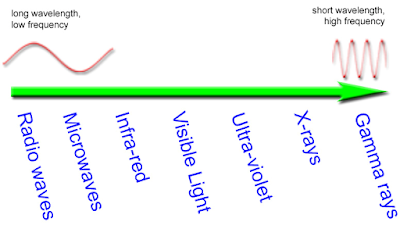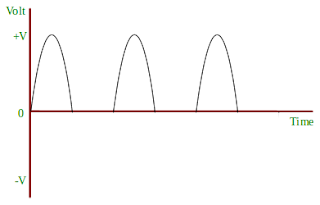ELECTROMAGNETISM!
Magnetic effect of current:
Remember
that a current-carrying conductor produces a magnetic field around it. If the
current direction is reversed, the magnetic field direction will be reversed
too, as shown in the diagram above.
A
dot in the wire, as shown above, shows the current coming out of the plane
whereas a cross in the wire shows the current moving into the plane.
Now
how to determine the direction, shown above, of the magnetic field?
The
right hand grip rule! Grip the wire with your right hand in such a way that the
thumb is pointing to the direction of the current. The curl of your fingers, in
turn, will show the direction of the magnetic field. Easy?
The
strength of the magnetic field in a long, straight current carrying wire
depends on
●
the
magnitude of the current. A larger current will produce a stronger magnetic
field around the wire.
●
the
distance from the wire. The strength of the field decreases as you move further
out.
Magnetic field pattern around a flat coil:
The
direction of the field can be determined by the Right Hand Grip Rule. Grip the
wire at one side of the coil with your right hand, with thumb pointing along
the direction of the current. Your other fingers will be pointing in the
direction of the field. Then do the same with the other side of the coil.
Plane
view of the flat coil:
In
a flat coil the strength of the magnetic field is closer in the centre of the
wire as you can see in the diagram above (closer field lines). To increase the
strength,
●
increase
the current ,
●
increase
the number of turns of the coil.
Magnetic field pattern of a solenoid:
A
solenoid is a long coil made up of a numbers of turns of wire. The magnetic
field of a solenoid resembles that of the long bar magnet, and it behaves as if
it has a North Pole at one end and a South Pole at the other.
You
would have noticed that it’s equal to increasing the turns of wire of flat coil
To
determine the poles in this case, again, apply right hand rule as shown below.
The fingers point towards the current direction while the thumb will show North
pole direction, as shown:
The
strength of the magnetic field in this case can be increased by
●
Increasing
the current,
●
Increasing
the number of turns per unit length of the solenoid,
●
Using
a soft-iron core within the solenoid.
Force on current carrying conductor:
Now
if you place the same current carrying wire in a magnetic field, the wire will
experience a force. The force is experienced due to the interactions between
the two magnetic fields (Which two? The one which we learned is produced by the
current carrying wire itself, and the one in which it is placed) which produces
a force on the conductor.
The
direction of the force should be known, and this can be found using the Fleming’s
left hand rule as shown in the diagram:
Notice
that the fore finger, middle finger and the thumb are perpendicularly to each
other. The forefinger points along the direction of the magnetic field, middle
finger points in the current direction and the thumb points along the direction
of the force.
The
strength of the force can be increased by
1. Increase the current
2. Using a stronger magnet.
And
the force direction can be controlled easily. It can be reversed by reversing
the direction of the current or the magnetic field.
Now let’s see how exactly a force is
experienced on the current-carrying conductor when placed in a magnetic field.
The interaction between the two magnetic fields is as shown below:
We
know that the field lines will always be from North to South. The direction of
the current is shown by the cross, which is into the plane. Now apply the left
hand rule and you’ll get the direction of the force which is 1 in the diagram.
Force on a moving charge in magnetic
field:
Now
if we consider a charge entering a magnetic field with direction into the
plane, the direction of current will be the convectional current direction i.e.
from positive to negative (the direction of current is shown). Now if you apply
left hand rule, you’ll get the direction of force it will experience, which
will be upwards.
Forces between two parallel
current-carrying conductors:
If
two parallel wires are placed together, we know they will generate a magnetic
field around them, right? The wires will experience a force. Why? Let’s see!
If
you right hand rule on the current carrying wires, you’ll get the direction of
the fields around them. Now if the direction of the current in both wires is
the same, they will attract. If, however, the direction is opposite, they will
repel. This is because the field direction in the wires with same current
direction will be the same. See the diagram carefully and draw it yourself,
you’ll understand how this happens.
Force on current-carrying rectangular coil
in a Magnetic field:
If
a current carrying coil is placed in a magnetic field (As shown in diagram
above), a pair of forces will be produced on the coil. This is due to the
interaction of the magnetic field of the permanent magnet and the magnetic
filed of the current carrying coil.
The
direction of the force can be determined by Fleming's left hand rule. Since the
current in both sides of the coil flow in opposite direction, the forces
produced are also in opposite direction. The 2 forces in opposite direction
constitute a couple which produces a turning effect to make the coil rotate.
This
phenomenon is used in a d.c. (direct current) motor. What does an electric
motor do? It simple converts electric energy to kinetic energy. The d.c. motor
consists a rectangular coil of wire placed between 2 permanent magnets. The
coil are soldered to a copper split ring known as commutator. 2 carbon brushes
are held against the commutator.
This
is shown below:
The
function of the brush is to conduct electricity from the external circuit to
the coil and allow the commutator to rotate continuously (since the brush is of
carbon, it conducts electricity).
The
function of the commutator is to change the direction of the current in the
coil and hence change the direction of the couple (the 2 forces in opposite
direction) in every half revolution. This is to make sure that the coil can
rotate continuously.

















































